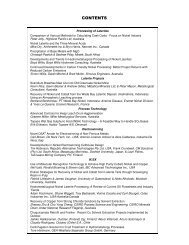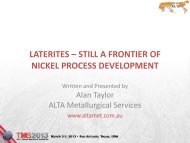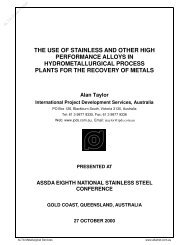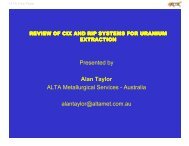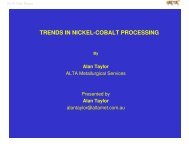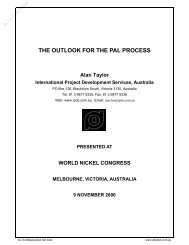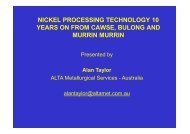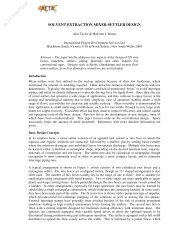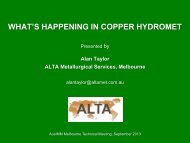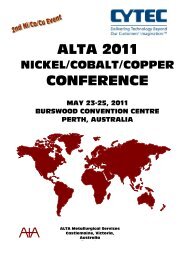Contents & Abstracts - ALTA Metallurgical Services
Contents & Abstracts - ALTA Metallurgical Services
Contents & Abstracts - ALTA Metallurgical Services
You also want an ePaper? Increase the reach of your titles
YUMPU automatically turns print PDFs into web optimized ePapers that Google loves.
<strong>ALTA</strong> 2012<br />
NICKEL/COBALT/COPPER<br />
CONFERENCE<br />
MAY 28-30, 2012<br />
BURSWOOD CONVENTION CENTRE<br />
PERTH, AUSTRALIA<br />
<strong>ALTA</strong> <strong>Metallurgical</strong> <strong>Services</strong><br />
Melbourne, Victoria,<br />
Australia<br />
www.altamet.com.au
Adam Fischmann, Ph.D.<br />
Research Scientist<br />
Metal Extraction Products<br />
Matthew Soderstrom<br />
Global Application Technology Manager<br />
Metal Extraction Products<br />
Ask The Mining Chemical Leaders<br />
For mining operators seeking improved performance, a dynamic collection of knowledge<br />
from the leading manufacturer of mining reagents is only a conversation or a mouse<br />
click away. Our team of metallurgists and engineers will work with you to find the right<br />
Cytec product, or develop a tailored solution, for your ore types and plant conditions.<br />
Our mining experts can match our portfolio of technologies to your unique needs and<br />
operational objectives. See for yourself what nearly a century of experience can bring.<br />
cytec.com/miningleaders<br />
Alumina Refining | Mineral Processing | Solvent Extraction<br />
Email: custinfo@cytec.com | Worldwide Contact info: www.cytec.com/miningleaders<br />
Contact Cytec US at Toll 1-800-652-6013, Free: 800-652-6013 +1 973-357-3193, | Tel: 973-357-3193<br />
or custinfo@cytec.com<br />
©2010 Cytec Industries Inc. All Rights Reserved.<br />
CYT0222.indd 1<br />
7/12/10 5:31:32 PM<br />
CYTEC / International Mining / CYT0222 / MEP
PROCEEDINGS OF<br />
NICKEL-COBALT-COPPER SESSIONS AT <strong>ALTA</strong> 2012<br />
MAY 28-30, 2012, PERTH, AUSTRALIA<br />
A Publication of<br />
<strong>ALTA</strong> <strong>Metallurgical</strong> <strong>Services</strong><br />
PO Box 68, Flinders Lane, Melbourne,<br />
Victoria 8009, Australia<br />
http://www.altamet.com.au<br />
ISBN: 978-0-9871262-3-8<br />
All rights reserved<br />
This publication may not be reproduced in whole or in part<br />
stored in a retrieval system or transmitted in any form or by any means<br />
without permission from the publisher<br />
The content of the papers is the sole responsibility of the authors<br />
To purchase a copy of this or other publications visit<br />
http://www.altamet.com.au/publications.htm
CONTENTS<br />
Processing of Laterites<br />
Comparison of Various Methods for Calculating Cash Costs - Focus on Nickel Industry<br />
Peter Jolly, Highland Pacific Ltd, Australia<br />
Nickel Laterite and the Three Mineral Acids<br />
Mike Dry, Arithmetek Inc.& Bryn Harris, Neomet Inc., Canada<br />
Precipitation of Base Metals with MgO<br />
Christoph Pawlick & Seshree Pillay, Mintek, South Africa<br />
Developments and Trends In Hydrometallurgical Processing of Nickel Laterites<br />
Boyd Willis, Boyd Willis Hydromet Consulting, Australia<br />
Continued Developments in Carbon Friendly Nickel Processing: Better Project Returns with<br />
Reduced Carbon Emissions<br />
Simon Willis, Sarah Mitchel & Brett Muller, Simulus Engineers, Australia<br />
Laterite Projects<br />
Scandium Breathes New Life Into Old Greenvale Nickel Mine<br />
Kevin Pery, Gavin Becker & Andrew Gillies, Metallica Minerals Ltd, & Peter Mason, <strong>Metallurgical</strong><br />
Consultant, Australia<br />
Recovery of Nickel and Cobalt from the Weda Bay Lateritic Deposit (Halmahera, Indonesia)<br />
Using an Atmospheric Leaching process<br />
Bertrand Berthomieu, PT Weda Bay Nickel, Indonesia; Antoine Dissaux, Eramet Nickel Division,<br />
& Yves Le Quesne, Eramet Research, France<br />
Process Technology<br />
Advanced Controls for Heap Leach Drum Agglomeration<br />
Graeme Miller, Miller <strong>Metallurgical</strong> <strong>Services</strong>, Australia<br />
Topsøe Wet Gas Sulphuric Acid (WSA) Technology – A Feasible Way to Handle SO 2 Gases<br />
Erik Eriksson, Haldor Topsøe A/S, Denmark<br />
Electrowinning<br />
Novel DSA ® Anode for Electrowinning of Non-Ferrous Metals<br />
Carl Brown, De Nora Tech, Inc., USA; Antonio Lorenzo Antozzi & Alice Calderara, Industrie De<br />
Nora, Italy<br />
Developments in Nickel Electrowinning Cellhouse Design<br />
Tim Robinson, Republic Alternative Technologies Pty Ltd, USA, Frank Crundwell, CM Solutions<br />
(Pty) Ltd, South Africa, Masatsugu Morimitsu, Doshish University, Japan, & Lauri Palmu,<br />
Talvivaara Mining Company Plc. Finland<br />
IX/SX<br />
Use of Molecular Recognition Technology to Achieve High Purity Cobalt, Nickel and Copper<br />
Neil Izatt, Ronald Bruening & Steven Izatt, IBC Advanced Technologies Inc., USA<br />
Elution Strategies for Recovery of Nickel and Cobalt from Laterite Tails through Scavenging<br />
Resin-in-Pulp<br />
Patrick Littlejohn & James Vaughan, University of Queensland; & Aleks Nikoloski, Murdoch<br />
University, Australia<br />
Hydrometallurgical Nickel Laterite Processing: A Review of Current SX Flowsheets and Industry<br />
Trends<br />
Adam Fischmann, Shane Wiggett, Troy Bednarski, Violina Cocalia and Cyril Bourget, Cytec<br />
Industries Inc., USA/Australia/Canada<br />
Recovery of Copper from Strong Chloride Solutions by Solvent Extraction<br />
Zhaowu Zhu & Chu Yong Cheng, CSIRO Process Science and Engineering, CSIRO Minerals<br />
Down Under National Research Flagship, Australia<br />
Chuquicamata Retrofit and Franke - Recent Cu Solvent Extraction Projects Implemented by<br />
Outotec<br />
Jarkko Hakkarainen, Outotec (Finland) Oyj, Finland; Alexis Villarroel, Arturo Sotomayor &<br />
Claudio Rodríguez, Outotec (Chile) S.A., Chile<br />
Centrifugation Solution for Crud Treatment in Hydrometallurgy Processes<br />
Tore Hartmann, GEA Westfalia Separator Group GmbH, Germany
Flotation<br />
Flotation of Copper Oxide Ores: A Review from Laboratory Testing to Industrial Practise<br />
Graeme Sheldon, AMML, Pty Ltd, Australia<br />
The Froth Flotation of Nickel Sulphide Ore Using PAX and Its Mixtures with DTC and DTP<br />
Walter Amos Ngobeni, Gregory Hangone & Daniel Ikhu-Omoregbe, Cape Peninsula University<br />
of Technology, South Africa<br />
Cobalt Recovery<br />
Not just another Cobalt Resource Review of Cobalt Processing Routes and the Value of<br />
Testwork<br />
Rogan Roulstone, MDM Engineering, South Africa<br />
The Hydrometallurgy and Activities Around Copper and Cobalt Recovery in the African<br />
Copperbelt<br />
Christoph Pawlick & Marian Lidall, Mintek, South Africa<br />
Equipment & Materials<br />
The Next generation of Pump Technology in PAL Plants<br />
Heinz Naegel & Stefan Willems, presented by Rudolf Gänsl, FELUWA Pumpen GmbH,<br />
Germany<br />
Numerical Design Tools Optimize Agitators, Vessels and Internals to Ensure Safe and<br />
Economic Plant Operation<br />
Wolfgang Keller, Jochen Jung, Nicole Rohn & Marc Stadtaus EKATO RMT, Germany<br />
Mortars for Acid Resistant Brick Linings in Hydrometallurgical Applications<br />
Kevin Brooks, Koch Knight LLC, USA, presented by Mark Martin, Koch Australia<br />
Hydroprocessing of Sulphides Forum<br />
Key Note Address, Hydroprocessing of Sulphides: Where Are We and Where Are We Going?<br />
David Dreisinger, University of British Colombia, Canada<br />
Bacterial Leaching at Elevated pH Using BioHeap TM Technology<br />
Jason Fewings & Shawn Seet, Western Areas NL, Australia<br />
High Temperature Heap Leaching of Ni, Cu & Co and Platinum, Group Metals from South<br />
African Platreef Concentrates Coated on Gravel<br />
Jacques Eksteen, Curtin University, Australia, Jochen Petersen, University of Cape Town;<br />
Steven Bradshaw & Guven Akdogan, University of Stellenbosch, South Africa<br />
Bulk Nickel-Copper Concentrates: A Comparison of Two Hydrometallurgical Processing Options<br />
David Jones, Teck Resources Limited/CESL Limited, Canada<br />
The Application and Economic Consideration of NSC Pressure Oxidation to Combined Copper<br />
Molybdenum Concentrates<br />
Corby Anderson, Colorado School of Mines, Todd Fayram, Continental <strong>Metallurgical</strong> <strong>Services</strong> &<br />
Larry Twidwell, Montana Tech, USA<br />
Developments In The Treatment Of Copper-Arsenic Concentrates<br />
Ken Baxter & Iman Ghanad, SNC-Lavalin, Australia & David Dixon, University of British<br />
Columbia, Canada<br />
Application of Mixed Chloride Technology for the Recovery of TiO 2 and Base Metals<br />
Vaikuntam Lakshmanan, Ram Sridhar & Raja Roy, Process Research Ortech Inc., Canada<br />
Development of a Versatile HCl-Leach Based Metal Extraction Technology Stack<br />
Dieter Vogl, Christian Haidinger, Benedikt Nowak & Herbert Weissenbaeck, SMS Siemag<br />
Process Technologies GmbH, Germany<br />
Kell Hydrometallurgical Process for Extraction of Platinum Group and Base Metals from Flotation<br />
Concentrates - An Update<br />
Keith Liddell, Lifezone Ltd, Switzerland & Mike Adams, Mutis Liber Pty Ltd, Australia
<strong>ALTA</strong> 2012<br />
NICKEL/COBALT/COPPER<br />
PROCESSING OF LATERITES<br />
1
COMPARISON OF VARIOUS METHODS FOR CALCULATING CASH COSTS -<br />
FOCUS ON NICKEL INDUSTRY<br />
By<br />
Peter Jolly<br />
Highlands Pacific Ltd, Australia<br />
Presenter and Corresponding Author<br />
Peter Jolly<br />
pjolly@highlandspacific.com<br />
ABSTRACT<br />
This paper has been prepared to help clarify the term “cash costs” and “unit cash costs (costs on a<br />
per mass basis)” which often appears in material associated with developing and promoting<br />
investment in mining ventures and mineral commodities.<br />
In a strict accounting sense the term cash costs has a specific meaning as it refers to the cost of<br />
transactions when using cash, credit or cheques. This paper is not referring to this definition or<br />
subject.<br />
In the mining industry, in an effort to quantify the costs associated with a mining venture, the term<br />
unit cash costs (often simply stated as the cash costs) are often cited as one of the indices to<br />
monitor and rank a specific venture’s performance against others. To be able to accurately carry out<br />
such an analysis requires a uniform approach and lots of data both from the producers and the<br />
smelters and refineries who take all play a part in transforming a mineral in the ground to a form that<br />
is useful to an end user, such as stainless steel producer, nickel plater, alloy manufacturer as is the<br />
case when referring to nickel.<br />
The paper has a focus on the nickel industry although should apply to other industries such as the<br />
copper, lead and zinc. The paper is not concerned with comparing one operation against another,<br />
rather it outlines and discusses the methods used to make this comparison. It is arguable that the<br />
nickel industry brings complications compared to say the copper industry, in that there are a variety<br />
of “finished products”, such as FeNi, nickel salts and pure nickel metal.<br />
As highlighted in this paper there are no standard internationally agreed methods used to calculate<br />
a cash cost curve, so care must be taken to examine the underlying assumptions when comparing<br />
cost curves.<br />
While the author originally set out to make a case for greater standardization in defining the term<br />
cash costs and the associated cash cost curves, the author is now of the opinion that this may not<br />
be possible due to the sensitivity of reporting commercial terms.<br />
There is no doubt that the use of the term cash costs will endure as it has become an often used<br />
measure of company operating performance as well as for analysts comparing industry trends.<br />
2
NICKEL LATERITE AND THE THREE MINERAL ACIDS<br />
By<br />
1 M. Dry and 2 B. Harris<br />
1 Arithmetek Inc., Canada<br />
2 Neomet Inc., Canada<br />
Presenter and Corresponding Author<br />
Mike Dry<br />
mike.dry@arithmetek.com<br />
ABSTRACT<br />
Recent literature reports laterite processes based on sulphate, chloride and nitrate chemistry. This<br />
paper presents a study of the mass/energy balances associated with processing limonite and<br />
saprolite via each of these three different routes, based on information published for each route.<br />
The mass/energy balances are analyzed and the variable operating costs potentially associated<br />
with each are calculated from the reagent and utility consumptions predicted by the mass/energy<br />
balances. The calculated reagent/utility costs are compared and discussed.<br />
20
PRECIPITATION OF BASE METALS USING MgO<br />
By<br />
MINTEK, South Africa<br />
Corresponding Author<br />
Seshree Pillay<br />
seshreep@mintek.co.za<br />
Presenter and Corresponding Author<br />
Christoph Pawlik<br />
Christophp@mintek.co.za<br />
ABSTRACT<br />
The utilisation of MgO as a precipitant for base metals has increased significantly over the past 5<br />
years, due to the relatively high grade base metal product that can be achieved when compared to<br />
lime. However, most base metal operations have found that the Mg content in the final product<br />
could be as high as 10-20% m/m Mg. This has major cost implications for an on-site refinery or for<br />
the sale and transport of an intermediate base metal hydroxide product. Reasons for the elevated<br />
Mg grades were identified as mode of reagent addition, precipitation temperature, ageing effects of<br />
MgO, as well as the grind size of the MgO. A suitable process route has been designed that<br />
improves the grade of the final mixed base metal hydroxide product by minimising the Mg content of<br />
the final product. A robust method for the determination of MgO reactivity within a typical base metal<br />
precipitation circuit is also discussed.<br />
37
DEVELOPMENTS AND TRENDS IN HYDROMETALLURGICAL PROCESSING OF<br />
NICKEL LATERITES<br />
By<br />
Boyd Willis<br />
Boyd Willis Hydromet Consulting, Australia<br />
Presenter and Corresponding Author<br />
Boyd Willis<br />
hydromet@boydwillis.com<br />
ABSTRACT<br />
To date the only nickel laterite acid leaching plants constructed have been based around high<br />
pressure acid leaching (HPAL) technology and the only other nickel laterite hydrometallurgical<br />
plants constructed have employed the Caron process. Several downstream recovery routes have<br />
been employed, including mixed sulphide precipitation (MSP), mixed hydroxide precipitation (MHP)<br />
and direct solvent extraction (DSX), with commercial products ranging from intermediates<br />
(MSP/MHP) to nickel oxide, nickel briquettes and nickel cathodes. Over the last decade<br />
considerable effort has been expended on the development of atmospheric and low pressure leaching<br />
processes (heap leaching and agitated tank leaching), as well as integrated flowsheets that<br />
re-generate the lixiviant and produce value-adding by-products. Much progress has been made<br />
towards the development of alternative downstream recovery processes, particularly in the field of<br />
DSX.<br />
This paper examines trends and new developments in hydrometallurgical processing of nickel<br />
laterite ores. Block flowsheets for the established and developmental processes are presented and<br />
the relative merits of each flowsheet are discussed.<br />
45
CONTINUED DEVELOPMENTS IN CARBON FRIENDLY NICKEL PROCESSING:<br />
BETTER PROJECT RETURNS WITH REDUCED CARBON EMISSIONS<br />
By<br />
Simon Willis, Sarah Mitchell & Brett Muller<br />
Simulus Engineers, Australia<br />
Presenter and Corresponding Author<br />
Brett Muller<br />
Brett.Muller@simulus.com.au<br />
ABSTRACT<br />
Simulus Engineers were awarded an AusIndustry grant in 2010 to co-fund the development of a<br />
novel process for the production of nickel metal from laterite ores. The Carbon Friendly Nickel<br />
Production (CFNP) process, involves membrane technology to recover sulphuric acid and reductive<br />
calcination to regenerate reactive magnesia from waste process liquor. The CFNP process is<br />
anticipated to reduce CO 2 emissions by over 60% from a base case conventional atmospheric leach<br />
/ neutralisation / mixed hydroxide process (MHP) flowsheet. This is achieved through lower process<br />
emissions by avoiding or significantly reducing the need for limestone and lime neutralisation of<br />
residual free acid, and reduced emissions from the transportation of reagents. The CFNP flowsheet<br />
can be applied to any sulphuric acid leach technology: PAL, atmospheric, or heap leach.<br />
Operating costs are estimated to be 25 to 48% lower than the conventional flowsheet depending on<br />
the flowsheet scenario chosen. Capital costs are similar to the conventional atmospheric leach<br />
flowsheet, but can be 29% lower, or 24% higher, depending on the scenario. The optimum scenario<br />
will depend on the ore body, project location and business strategy of any company seeking to<br />
implement the technology.<br />
Simulus Engineers will be operating a demonstration plant to showcase the new process in late<br />
2012, in conjunction with further testwork to optimise leach, iron removal, manganese removal and<br />
magnesia recovery process parameters.<br />
77
<strong>ALTA</strong> 2012<br />
NICKEL/COBALT/COPPER<br />
LATERITE PROJECTS<br />
85
SCANDIUM BREATHES NEW LIFE INTO OLD GREENVALE NICKEL MINE<br />
By<br />
1 Kevin Pery, 1 Gavin Becker, 1 Andrew Gillies & 2 Peter Mason<br />
1 Metallica Minerals Ltd (MLM), Australia<br />
2 <strong>Metallurgical</strong> Consultant, Australia<br />
Presenter and Corresponding Author<br />
Kevin Pery<br />
kpery@metallicaminerals.com.au<br />
ABSTRACT<br />
Metallica Minerals Ltd (ASX:MLM) is planning to install a high-pressure acid leach (HPAL) operation<br />
at its tri-metal flagship NORNICO project. The mineral resources of which are primarily located<br />
between the townships of Mt Garnet and Greenvale in North Queensland. Metallica’s initial<br />
development focus is in NORNICO’s southern area which includes the remaining nickel-cobalt<br />
laterite resources at the Greenvale Nickel Mine site and the scandium-cobalt rich nickel resources<br />
at the Lucknow deposit near the Greenvale township. The project also encompasses the Bell Creek<br />
nickel-cobalt resource (32km south of Mt Garnet), the Minnamoolka nickel resources (30km south<br />
of Bell Creek) and the cobalt-scandium-rich Kokomo nickel resource (55km north of Greenvale).<br />
Although historically the Greenvale Nickel mine has yielded around 40Mt @ 1.56% Ni and 0.12%<br />
Co, there remains for the NORNICO project, in the 200km long belt, a combined JORC<br />
nickel-cobalt Resource of 50.3Mt @ 0.81% Ni and 0.09% Co. In addition the project contains a<br />
combined scandium resource of 16.8Mt @ 130g/t Sc. It is the latter, along with novel, proprietary<br />
process technology capable of recovering high purity scandium oxide, that will enable Metallica to<br />
breathe new life into the historic Greenvale nickel mine and adjacent ore bodies. The intent is to<br />
process 750,000tpa of combined nickel-cobalt-scandium laterite ores for at least 20 years,<br />
increasing the scandium production in step with the increasing scandium demand anticipated once<br />
this reliable, long term supply becomes available to key customers.<br />
This presentation will provide an update of the project status and an overview of the environmental,<br />
metallurgical and engineering work currently in progress to expedite the project and, subject to a<br />
Feasibility Study, meet Metallica’s planned development schedule through to process plant<br />
commissioning in late 2015.<br />
86
RECOVERY OF NICKEL AND COBALT FROM THE WEDA BAY LATERITIC<br />
DEPOSIT (HALMAHERA, INDONESIA) USING AN ATMOSPHERIC LEACHING<br />
PROCESS<br />
By<br />
1 Bertrand Berthomieu, 2 Antoine Dissaux, 3 Yves Le Quesne<br />
1 PT Weda Bay Nickel, Indonesia<br />
2 Eramet, Nickel Division, France<br />
3 Eramet Research, France<br />
Presenter and Corresponding Author<br />
Bertrand Berthomieu<br />
bertrand.berthomieu@erametgroup.com<br />
ABSTRACT<br />
The Weda Bay Nickel Project comprises the establishment of mining, hydrometallurgical processing<br />
and support infrastructure facilities in the Bay of Weda on Halmahera Island in East Indonesia<br />
where PT Weda Bay Nickel (WBN) holds the rights to develop a major nickel-cobalt laterite<br />
resource under a Contract of Work (COW) with the Government of Indonesia.<br />
The process has been specifically design to accommodate the specificity of the ore resources: high<br />
saprolite ratio, difficulties and low interest to separate the different lithological horizons (limonite,<br />
earthy or rocky saprolite), high level of serpentinization.<br />
The custom made atmospheric leaching approach and the retained solution processing have been<br />
retained to accommodate the resources specificities, to take into account the business model<br />
objectives, the site conditions and the stringent objectives for health, safety and environment.<br />
The paper describes the main features of the retained process and the key drivers behind the<br />
retained options.<br />
96
<strong>ALTA</strong> 2012<br />
NICKEL/COBALT/COPPER<br />
PROCESS TECHNOLOGY<br />
113
ADVANCED CONTROLS FOR HEAP LEACH DRUM AGGLOMERATION<br />
By<br />
Graeme Miller<br />
Miller <strong>Metallurgical</strong> <strong>Services</strong>, Australia<br />
Presenter and Corresponding Author<br />
Graeme Miller<br />
gmiller@millermet.com<br />
ABSTRACT<br />
Recent work has shown that the quality of the agglomerates, produced for heap leaching, are an<br />
integral part of ensuring fast kinetics for the recovery of the target metal values. The moisture<br />
content is the critical parameter that produces a tighter agglomerate size distribution. However too<br />
high a moisture content can cause materials handling issues, as the agglomerates become too<br />
sticky. With even higher moisture contents the agglomerate structure collapses as the solids enter<br />
the plastic state.<br />
The other key variable to faster leach kinetics is the addition of the correct amount of acid to the<br />
agglomeration process. The acid addition rate is a function of the main gangue acid consuming<br />
minerals. These can be characterised by their marker elements that relate directly to the gangue<br />
mineralogy. Acid addition rate is not normally changed very often; and over or under use is<br />
common.<br />
Existing controls on agglomerate quality are basic with acid and moisture added on a mass ratio to<br />
the feed solids. These are adjusted periodically (every few hours or days) based on manual<br />
empirical test such as the squeeze and drop-shatter tests. Short term changes in ore characteristics<br />
are not considered due to the lack of real time agglomerate quality measurement.<br />
By making use of existing on-line instrumentation, the quality of agglomerates can be improved<br />
significantly: with control of acid addition based on marker element analysis, and moisture addition<br />
based on the physical attributes of the resultant agglomerates. All of this instrumentation is<br />
commercially available and can be added to the existing controls to provide the benefits of improved<br />
leach kinetics and acid consumption management. Specific instruments and control algorithms are<br />
described along with methods of incorporation in the plant.<br />
114
TOPSØE WET GAS SULFURIC ACID (WSA) TECHNOLOGY –<br />
A FEASIBLE WAY TO HANDLE SO 2 GASES<br />
By<br />
Erik Eriksson<br />
Haldor Topsøe A/S, Denmark<br />
Presenter and Corresponding Author<br />
Erik Eriksson<br />
erse@topsoe.dk<br />
ABSTRACT<br />
This paper describes the Topsøe WSA technology which was developed and commercialized<br />
during the early 1980s. The technology has, in practice, proven to be viable in treating SO 2 bearing<br />
off-gases from non-ferrous operations ever since Topsøe commissioned the first WSA plant to treat<br />
molybdenum sulfide roaster off-gas in 1986. The WSA technology has demonstrated its superiority<br />
when it comes to total lifetime cost, taking not only the low investment cost, but also the attractive<br />
operating income into consideration.<br />
The WSA technology is well suited for production of concentrated sulfuric acid of commercial<br />
quality from the sulfur dioxide (SO 2 ) gas that inevitably emerges from the metallurgical processes.<br />
Some of the features that make the WSA technology attractive for this application are:<br />
• High SO 2 conversion rates (>99%)<br />
• High energy efficiency leading to a low autothermal point (~ 3% SO 2 )<br />
• No need for gas cooling and drying to produce concentrated sulfuric acid<br />
• No production of waste<br />
• Very low cooling water consumption<br />
This paper will describe the WSA process principles and also highlight features that make this process<br />
attractive for handling SO 2 gases.<br />
127
<strong>ALTA</strong> 2012<br />
NICKEL/COBALT/COPPER<br />
ELECTROWINNING<br />
139
NOVEL DSA ® ANODE FOR ELECTROWINNING OF NON-FERROUS METALS<br />
By<br />
1 Carl W. Brown, Jr., 2 Antonio L. Antozzi & 2 Alice Calderara<br />
1 De Nora Tech, USA<br />
2 Industrie De Nora, Italy<br />
Presenter and Corresponding Author<br />
Carl brown<br />
carl.brown@denora.com<br />
ABSTRACT<br />
The result of extensive research into fundamental mixed metal oxide catalyst morphology has produced<br />
a next generation all titanium DSA ® anode. This new DSA ® anode, patent pending, is tailored for<br />
electrowinning of non-ferrous metals (copper, nickel, cobalt, zinc) by means of this new coating<br />
technology, already utilised in the chlor-alkali world. These DSA ® anodes are characterised by a hanger<br />
bar with vertical distributor bars, having primary titanium mesh attached by weldments. The active mesh<br />
is provided with noble-metal electrocatalytic coatings, consisting of iridium and/or ruthenium oxides,<br />
obtained by thermal decomposition of precursor solutions applied to the titanium substrates. The<br />
catalytic activity of state-of-the-art DSA ® anodes is improved by about 80 mV by controlling the<br />
crystallite size of the noble-metals without decreasing the decomposition temperature. It is known that<br />
below a certain value (typically 400°C) the stability of these oxides, and associated lifetime, is seriously<br />
compromised. A highly active DSA ® anode, consisting of a quasi-amorphous phase, is obtained at high<br />
temperature (above 450°C), therefore not compromising lifetime performance. Through optimisation of<br />
these design parameters, the manufacture of these novel anodes was identified. DSA ® anodes<br />
performance advantages include: lead-free ‘green’ all titanium anodes, true lead-free cathode quality,<br />
energy savings of 0.3 to 0.55 V can be realized depending on the EW application when compared to<br />
industry standard lead-alloy anodes, sustainability designed into long-life recoatable anode structures,<br />
increase plant cathode output through increased current density operations, eliminate need for cobalt<br />
sulphate addition required for lead anodes, improved plant on-stream production, no sludge generated<br />
or removed, and improved current distribution producing smooth high efficiency cathode.<br />
140
146
<strong>ALTA</strong> 2012<br />
NICKEL/COBALT/COPPER<br />
IX/SX<br />
167
USE OF MOLECULAR RECOGNITION TECHNOLOGY TO ACHIEVE HIGH PURITY<br />
COBALT, NICKEL, AND COPPER<br />
By<br />
Neil E. Izatt, Ronald L. Bruening & Steven R. Izatt<br />
IBC Advanced Technologies, Inc., U.S.A.<br />
Presenter and Corresponding Author<br />
Neil E. Izatt<br />
nizatt@ibcmrt.com<br />
ABSTRACT<br />
Modern technology requires ultra-pure cobalt, nickel, and copper for use in products that are critical<br />
to the economy. Impurities in these metals can result in serious impairment of downstream metal<br />
products through structural weakness or failure, lowered performance levels, diminished longevity,<br />
and increased danger of fire or explosion. Thus, a large economic incentive exists to produce these<br />
metals in highly purified form either from primary sources, waste streams, or recycling. IBC’s<br />
Molecular Recognition Technology (MRT) process offers proven procedures, presently used<br />
commercially, for removing impurities from refining streams containing these metals. The MRT<br />
process is described with examples of its use together with a description of the technical and<br />
environmental advantages it offers to the metal refinery.<br />
168
ELUTION STRATEGIES FOR RECOVERY OF NICKEL AND COBALT FROM<br />
LATERITE TAILS THROUGH SCAVENGING RESIN-IN-PULP<br />
By<br />
1 Patrick Littlejohn 1 James Vaughan<br />
2 Aleks Nikoloski<br />
1 The University of Queensland, Australia<br />
2 Murdoch University, Australia<br />
Presenter and Corresponding Author<br />
Patrick Littlejohn<br />
p.littlejohn@uq.edu.au<br />
ABSTRACT<br />
The loss of residual nickel and cobalt to tailings streams represents a large inefficiency in many<br />
existing laterite operations. The majority of these losses can be avoided through treatment of<br />
tailings with scavenging resin-in-pulp. The resin produced through such circuits is loaded with a<br />
high proportion of impurity metals, complicating downstream processing. Selective elution of resin<br />
to recover nickel and cobalt preferentially over impurity metals can be carried out with multistage<br />
acid stripping or single stage ammoniacal stripping. Each option allows different methods for<br />
production of saleable material to reclaim value metal that would have otherwise been lost.<br />
178
HYDROMETALLURGICAL NICKEL LATERITE PROCESSING:<br />
A REVIEW OF CURRENT SX FLOWSHEETS AND INDUSTRY TRENDS<br />
By<br />
Adam Fischmann, Shane Wiggett, Troy Bednarski, Violina Cocalia and Cyril Bourget<br />
Cytec Industries Inc.<br />
Presenter and Corresponding Author<br />
Adam Fischmann<br />
adam.fischmann@cytec.com<br />
ABSTRACT<br />
The state of the art of nickel and cobalt solvent extraction in the nickel laterite industry is assessed,<br />
covering the reagents in commercial use (organophosphorus reagents, carboxylic acids, chelating<br />
oximes and amines), research developments and chemical fundamentals that result in the different<br />
approach taken with each of the reagent types.<br />
191
RECOVERY OF COPPER FROM STRONG CHLORIDE SOLUTIONS BY SOLVENT<br />
EXTRACTION<br />
By<br />
Zhaowu Zhu & Chu Yong Cheng<br />
CSIRO Process Science and Engineering<br />
CSIRO Minerals Down Under National Research Flagship, Australia,<br />
Presenter and Corresponding Author<br />
Chu Yong Cheng<br />
chu.cheng@csiro.au<br />
ABSTRACT<br />
A new mixed solvent extraction system consisting of LIX 63, LIX 860 and TBP was developed to<br />
extract and transfer copper from strong chloride solutions to sulphate solutions for conventional<br />
electrowinning. Copper is separated from other base metals such as iron, nickel, zinc, etc. in<br />
extraction. The co-extracted impurities are removed with reasonably strong chloride solution by<br />
scrubbing. The chloride in the impurity-removed organic solution is scrubbed with weak chloride<br />
solution. Copper is readily stripped from the scrubbed organic solution to generate copper<br />
electrolyte containing very small amount of chloride (36 mg/L) and iron (5 mg/L) suitable for<br />
electrowinning. Further research work is required to optimise the organic system and the iron and<br />
chloride scrubbing steps.<br />
Based on the new mixed solvent extraction system, a conceptual process flowsheet has been<br />
proposed with the advantages of:<br />
• Copper can be transferred from chloride to sulphate solution with one solvent extraction<br />
circuit.<br />
• No expensive base is required for copper extraction and transfer to sulphate solution for<br />
electrowinning.<br />
• Iron, other base metals and chloride can be scrubbed from the loaded organic solution.<br />
• Copper can be readily stripped to recycle the organic solution and generate suitable<br />
electrolyte for electrowinning.<br />
203
CHUQUICAMATA RETROFIT AND FRANKE - RECENT CU SOLVENT EXTRACTION<br />
PROJECTS IMPLEMENTED BY OUTOTEC<br />
By<br />
1 Jarkko Hakkarainen, 2 Alexis Villarroel, 2 Arturo Sotomayor and 2 Claudio Rodríguez<br />
1 Outotec (Finland) Oyj, Finland<br />
2 Outotec (Chile) S.A., Chile<br />
Presenter and Corresponding Author<br />
Jarkko Hakkarainen<br />
jarkko.hakkarainen@outotec.com<br />
ABSTRACT<br />
Development of Outotec VSF ® technology dates back to the 1970’s, the first commercial application<br />
being Kokkola Mo SX Plant in Finland (1977). Zaldívar in Chile was the first Cu SX plant to utilize<br />
the technology (1995), which has gone through several versions and incremental improvements<br />
from the first projects to the most recent. The latest projects are retrofit project of Chuquicamata<br />
Oxide Plant Train A (start-up in 2008), Franke Cu SX-EW (2009), Assarel Cu SX-EW (2010), Tia<br />
María Cu SX-EW (start-up date unknown), Caserones Cu SX-EW (2012), a confidential U SX<br />
project (2012) and a confidential Co/Ni SX project (after 2015).<br />
The objective of this paper is to discuss the experiences of the Chuquicamata and Franke projects<br />
and specifically the results of technological improvements implemented in them. The Chuquicamata<br />
retrofit project was the first of its kind executed by Outotec, with incorporation of VSF technology in<br />
an existing, operative solvent extraction train to increase its PLS processing capacity. Downtime<br />
required for the installation of VSF equipment was minimized by incorporation of by-pass pipelines<br />
to the separate stages and installing the VSF equipment stage by stage, keeping the train in<br />
operation during the whole intervention sequence. In the Franke Project, a new concept of<br />
combined Washing stage and Loaded Organic tank was utilized for the first time, providing<br />
approximately 15% CAPEX reduction for the SX plant. Additionally, Outotec ® Reverse settler design<br />
was utilised in order to further optimize the plant layout in terms of operational ergonomics.<br />
213
CENTRIFUGATION SOLUTION FOR CRUD TREATMENT IN HYDOMETALLURGY<br />
PROCESSES<br />
By<br />
Tore Hartmann<br />
GEA Westfalia Separator Group GmbH, Germany<br />
Presenter and Corresponding Author<br />
Tore Hartmann<br />
Tore.Hartmann@gea.com<br />
ABSTRACT<br />
In the hydrometal process, the presence of the so-called “crud” is a constant challenge in solvent<br />
extraction. Crud is a stable emulsion which forms along the interface between the aqueous and<br />
organic phase. The spread is influenced by the following parameters: first, wind blows the dust and<br />
impurities into the open sedimentation tanks. Second, the undissolved solids such as sand<br />
transported in the PLS cause problems in conjunction with incorrect agitator design.<br />
The crud fraction can decisively impact the efficiency of the hydrometal extraction because the<br />
phase interface can constitute a large fraction and the sedimentation tanks cannot react flexibly to<br />
it. In the downstream process of the series-connected sedimentation tanks, they are thus all<br />
contaminated with crud. At the same time, the necessary mass transport is significantly impeded at<br />
the phase boundary between organic phase and aqueous phase due to the crud formation.<br />
The transfer of the organic phase into the electrolysis cell can result in a “burnout” of the cathode.<br />
The carry-over of this electrolyte into the extraction can cause problems with the pH regulation. The<br />
carry-over of the organic components into the raffinate also leads to contamination of the leaching<br />
circuit.<br />
The continuous treatment of the crud with a 3-phase decanter centrifuge is extremely effective in<br />
combating this. This technology splits all three phases from each other and they are consequently<br />
continuously separated. All subsequent process steps exhibit a stable, uniform effectiveness. The<br />
main advantage for the user is that fluctuations in the process are eliminated and the organic phase<br />
can be recirculated back to extraction. The recycling of the solvent alone justifies the investment in<br />
less than 6 months as examples from South Africa and Chile show.<br />
To operate solvent recovery in daily operation fully automated online at the optimum limit, the<br />
decanter centrifuge is equipped with a concentration-dependent pond adjustment called DControl®.<br />
By this means, the users can be guaranteed the maximum possible solvent recovery and minimise<br />
the solvent costs in this process step. This system is presented in detail in this paper.<br />
221
<strong>ALTA</strong> 2012<br />
NICKEL/COBALT/COPPER<br />
FLOTATION<br />
230
FLOTATION OF OXIDE COPPER ORES: A REVIEW FROM LABORATORY<br />
TESTING TO INDUSTRIAL PRACTICE<br />
By<br />
Graeme Sheldon<br />
AMML Pty Ltd, Australia<br />
Presenter and Corresponding Author<br />
Graeme Sheldon<br />
Graeme.Sheldon@tpg.com.au<br />
ABSTRACT<br />
Flotation has been used for many years as a method for recovering and upgrading oxide copper<br />
minerals into mineral concentrates. The traditional approach has been based on sulphidisation of<br />
the oxide copper minerals surfaces followed by collector to render these surfaces hydrophobic.<br />
Sulphidisation processes usually are very effective and efficient at laboratory scale, however are<br />
more problematic at industrial scale leading to inferior plant performance compared to laboratory<br />
performance. In more recent times, the use of hydroxamate collectors has been demonstrated to be<br />
effective at both laboratory and industrial scale for oxide copper mineral flotation, and commercial<br />
quantities of hydroxamates are now available for commercial use.<br />
(Note: Author unable to attend the Conference)<br />
231
THE FROTH FLOTATION OF NICKEL SULPHIDE ORE USING PAX AND ITS MIXTURES<br />
WITH DTC AND DTP<br />
By<br />
Walter Amos Ngobeni, Gregory Hangone & Daniel Ikhu-Omoregbe<br />
Cape Peninsula University of Technology, South Africa<br />
Presenter and Corresponding Author<br />
Walter Amos Ngobeni<br />
Walterngo1@gmail.com<br />
ABSTRACT<br />
Froth flotation is a method used to separate the desired mineral particles from the associated<br />
gangue mineral based on the differences in their hydrophobicity. It is used to treat nickel sulphide<br />
ores containing pyrrhotite, pentlandite and magnesium oxide. The Collectors are the reagents used<br />
in the froth flotation to impart the hydrophobicity to the desired mineral.<br />
Potassium amyl xanthate (PAX) is one of the preferred collectors used in froth flotation of nickel<br />
sulphide ores. The xanthate collectors are sensitive to pH and their selectivity in treating complex<br />
ores is questionable. With deteriorating nickel sulphide ore reserves more selective collectors have<br />
to be used in the extraction of nickel. The dithiophosphates are believed to be more selective than<br />
xanthates but cost more.<br />
The addition of a second collector in the froth flotation system improves surface coverage which is<br />
promoted by the collector co-adsorption. The synergistic effects or linear summation of constituents’<br />
adsorption characteristics may improve the overall flotation performance with regard to recovery<br />
and grade.<br />
PAX was mixed with either sodium di-methyl dithiocarbamate (di-C 1 -DTC) or sodium di-ethyl<br />
dithiophosphate (di-C 2 -DTP) to investigate whether there were any improvements in recoveries and<br />
grades compared to pure xanthate collectors. The following mixtures were tested in this work<br />
90% PAX and 10% di-C 1 -DTC; 90% PAX and 10% di-C 2 -DTP; 70% PAX and 30% di-C 1 -DTC; and<br />
70% PAX and 30% di-C 2 -DTP<br />
This study showed that the mixture 90% PAX and 10% di-C 1 -DTC yielded higher nickel recovery<br />
and nickel grade than the pure PAX. It was not beneficial to use both mixtures of PAX with di-C 2 -<br />
DTP. The nickel recoveries and nickel grades obtained with the use of these mixtures were lower<br />
than those obtained with pure PAX.<br />
(Note: Author unable to attend the Conference)<br />
238
<strong>ALTA</strong> 2012<br />
NICKEL/COBALT/COPPER<br />
COBALT RECOVERY<br />
250
NOT JUST ANOTHER COBALT RESOURCE- REVIEW OF COBALT PROCESSING<br />
AND THE VALUE OF TEST WORK.<br />
By<br />
Rogan Roulstone<br />
MDM Engineering- South Africa<br />
Presenter and Corresponding Author<br />
Rogan Roulstone<br />
rogan@mdm-engineering.com<br />
ABSTRACT<br />
As a member of an engineering and procurement company our primary function is to assist our<br />
clients with detail engineering and costing of the ore process plant. The process of arriving at the<br />
final design often but not always follows the following steps:<br />
A scoping study<br />
A pre-feasibility study<br />
A feasibility study<br />
And finally a bankable study<br />
Each step has been honed over the years/months to produce a more accurate level of engineering<br />
and along with that a more detailed costing, culminating in an overall financial model that either<br />
indicates the need to build a process plant.<br />
More often than not one of the criteria for an EPCM selection is the amount of in-house<br />
expertise or experience from consultants with the applicable commodity.<br />
Why test work? Surely similar ores bodies should exhibit similar characteristics.<br />
It can be debated that the cost of test work is a long and often tedious process, further made<br />
arduous by overloaded and understaffed laboratories.<br />
So is test work over rated can you get away with none or at least very little? Secondly what is the<br />
lost opportunity cost? Thirdly and more importantly is whose money am I spending? And what are<br />
the conditions attached.<br />
This paper attempts to compare two process plants, one built with little or no test work and one with<br />
a large amount of test work- not yet built.<br />
251
THE HYDROMETALLURGY AND ACTIVITIES AROUND COPPER AND COBALT<br />
RECOVERY IN THE AFRICAN COPPERBELT<br />
By<br />
Christoph Pawlik & Marian Lydall<br />
Mintek, South Africa<br />
Presenter and Corresponding Author<br />
Christoph Pawlik<br />
christophp@mintek.co.za<br />
ABSTRACT<br />
The Copperbelt in Central Africa, which includes Zambia and the Democratic Republic of Congo<br />
(DRC), are well-known mineral-rich mining areas. Interest in the Copperbelt has resurged in recent<br />
years, primarily due to the upturn in international commodity prices and major projects have been<br />
commissioned or expanded in the Copperbelt over the past 5 years. Generally, projects in these<br />
areas produce copper metal as primary product, with an intermediate cobalt precipitate or cobalt<br />
metal as a by-product.<br />
Hydrometallurgical processing forms an integral part of the recovery and purification of copper and<br />
cobalt. The conventional hydrometallurgical approach for treating ores in this region involves a<br />
sulphuric acid leach circuit in a loop with Cu solvent extraction and Cu electrowinning. In order to<br />
recover and purify cobalt, a copper raffinate bleed stream is typically taken from which impurities<br />
are removed and the cobalt is upgraded in multiple unit operations. The complexity of the<br />
downstream purification of cobalt is dependent on the type and purity of cobalt product that is to be<br />
produced, and the value that could be realised for the specific product.<br />
Macro-economic factors such as the social and political environment, resource size, value metal<br />
grades, local infrastructure, environmental aspects, and certain other risks are critical<br />
considerations for process selection and financial investment. Some of these aspects are discussed<br />
hand-in-hand with the metallurgical processing options for projects in the Copperbelt.<br />
268
<strong>ALTA</strong> 2012<br />
NICKEL/COBALT/COPPER<br />
EQUIPMENT & MATERIALS<br />
287
THE NEXT GENERATION OF PUMP TECHNOLOGY IN PAL PLANTS<br />
By<br />
Heinz M. Naegel, Dr. Stefan Willems<br />
FELUWA Pumpen GmbH, Germany<br />
Presenter<br />
Rudolf Gänsl<br />
gaensl@feluwa.de<br />
Corresponding Author<br />
Heinz Naegel<br />
Naegel@feluwa.de<br />
ABSTRACT<br />
PAL plants require the use of special pump equipment, not only for Autoclave feeding but also for<br />
acid supply, thickeners, choke water, seal water make-up and transportation such as slurry<br />
pumping from the mine to the plant and tailings transport from the plant to the reservoir.<br />
The pumps for these applications have a common key characteristic: They have to ensure efficient<br />
and reliable operation under the most arduous of operating conditions. For this reason, selection of<br />
the most suitable pump technology and construction materials is most vital.<br />
The MULTISAFE double hose-diaphragm pump is the best suited pump type for these applications.<br />
The fluid is linearly conveyed through the double hose-diaphragm and does not get in contact with<br />
the pump head housing. Two hose-diaphragms provide a double hermetic sealing from the<br />
hydraulic drive end.<br />
Latest ball valve technology and the respected material selection ensure long life time, fastest valve<br />
change (Quick Change System) and lowest spare part costs.<br />
Covering a range from 1m³/h up to 1000m³/h and pressures up to 400bar, various MULTISAFE<br />
gear and pump head combinations provide the best fit for all applications. The new single-acting<br />
quintuplex MULTISAFE (QGK) reciprocating pumps are able to reduce the kinematic irregularity<br />
down to just 5.1% (vs. 23.0% for that of single-acting three cylinder pumps) even without a pulsation<br />
dampener.<br />
The MULTISAFE pumps provide the highest energy efficiency of all types of diaphragm pumps and<br />
help to reduce the energy costs tremendously.<br />
288
NUMERICAL DESIGN TOOLS OPTIMIZE AGITATORS, VESSELS AND INTERNALS<br />
TO ENSURE SAFE AND ECONOMIC PLANT OPERATION<br />
By<br />
Wolfgang Keller, Jochen Jung, Nicole Rohn & Marc Stadtaus<br />
EKATO RMT, Germany<br />
Presenter and Corresponding Author<br />
Wolfgang Keller<br />
Wolfgang.Keller@ekato.com<br />
ABSTRACT<br />
The Increase in profitability is a common ‘must’ for production processes. In minerals processing<br />
this can be observed with production plant sizes being constantly increased and the requirement of<br />
higher plant availabilities. In hydrometallurgical plants agitated tanks are for example employed for<br />
atmospheric leach, neutralization etc. applications. Requirements in these applications can be very<br />
complex since quite often multiple phases have to be processed. This might require agitator<br />
designs with an increased level of power input leading to high dynamic loads on the vessel itself<br />
and all vessel internals such as feed pipes. These have to be considered with regard to safe<br />
operation to avoid resonance problems etc.<br />
Although the classical methods of process and mechanical engineering are still indispensable new<br />
numerical methods are well established to design these complex agitated systems.<br />
This paper presents examples of applications where numerical analysis has benefits. One example<br />
shows the importance of the educt feed positions required to generate a homogeneous product in a<br />
continuously operated reactor, another process oriented example illustrates the loads imposed on<br />
internal parts in a large vessel.<br />
301
MORTARS FOR ACID RESISTANT BRICK LININGS<br />
IN HYDROMETALLURICAL APPLICATIONS<br />
By<br />
Kevin Brooks<br />
Koch Knight LLC, USA<br />
Presented by<br />
Mark W Martin<br />
Koch Australia, Koch Knight Division<br />
mark.martin@kochknight.com<br />
Corresponding Author<br />
Kevin Brooks<br />
Koch Knight LLC, USA<br />
ABSTRACT<br />
The application of hydrometallurgy in the recovery of nickel, copper gold and other metals continues<br />
to grow. Acid brick linings have been proven to provide economical and reliable service in acid<br />
leach vessels, pressure oxidation autoclaves, pressure let down vessels, and other related<br />
equipment. Careful attention must be given to all of the components including the mortar selection<br />
and application to achieve a reliable lining system. An understanding of the properties and<br />
limitations of the mortar as well as the process conditions will allow for the selection of the best<br />
mortars to provide a reliable lining.<br />
313
<strong>ALTA</strong> 2012<br />
NICKEL/COBALT/COPPER<br />
HYDROPROCESSING OF<br />
SULPHIDES FORUM<br />
318
319
BACTERIAL LEACHING AT ELEVATED pH USING BIOHEAP TECHNOLOGY<br />
By<br />
Jason Fewings & Shawn Seet<br />
Western Areas NL, Australia<br />
Presenter and Corresponding Author<br />
Jason Fewings<br />
jfewings@westernareas.com.au<br />
ABSTRACT<br />
Many low grade nickel sulphide ores are hosted in gangue containing high levels of magnesium<br />
silicates, which consequently consume a large amount of sulphuric acid in conventional bacterial<br />
leaching scenarios where solution pH’s below 2 are required. BioHeap has developed a saline<br />
tolerant bacterial culture using patented methods, that is capable of operating at elevated pH’s at<br />
levels where ferric iron precipitates out of solution. Operating at elevated pH has the dual<br />
advantage of significantly reducing the acid consumption and reducing limestone demand for iron<br />
disposal.<br />
Further work is planned to critically compare the performance of the high pH culture against cultures<br />
operating at conventional pH and to expand the range of cultures that are capable of operating at<br />
high pH.<br />
365
373
THE APPLICATION AND ECONOMIC CONSIDERATION OF NSC PRESSURE<br />
OXIDATION TO COMBINED COPPER MOLYBDENUM CONCENTRATES<br />
By<br />
1 Corby G. Anderson, 2 Todd S. Fayram & 3 Larry G. Twidwell<br />
1 Colorado School of Mines, USA<br />
2 Continental <strong>Metallurgical</strong> <strong>Services</strong>, USA<br />
3 Montana Tech, USA<br />
Presenter and Corresponding Author<br />
Corby Anderson<br />
cganders@mines.edu<br />
ABSTRACT<br />
The need for copper and molybdenum continues to grow as does the need for clean efficient<br />
metallurgical technologies capable of treating mixed metal concentrates. Currently, the use of<br />
hydrometallurgical pressure oxidation for copper concentrate treatment is growing. Furthermore,<br />
with limited molybdenum roasting capacity, stringent industrial molybdenum concentrate roaster<br />
feed specifications, poor rhenium recoveries, and the inherent environmental issues associated with<br />
pyrometallurgical treatments, hydrometallurgical options are also now being pursued for<br />
molybdenum concentrates. Moreover, given the inherent grade, recovery and cost inefficiencies in<br />
the differential flotation process normally employed for molybdenum concentrates produced as a<br />
by-product of copper mining, there is a growing need to directly treat combined bulk copper and<br />
molybdenum concentrates. This minimizes molybdenum concentrate roasting limitations,<br />
specifications and requirements, while allowing simplification of increased efficiency of and cost<br />
reductions in upstream mineral processing circuits now producing separate copper and<br />
molybdenum concentrates by differential flotation. It would also allow more direct and efficient<br />
recovery of rhenium. Finally, hydrometallurgical technology will also reduce the need for costly final<br />
molybdenum concentrate impurity treatment circuits, thereby allowing for lower grade mixed metal<br />
molybdenum concentrates to be treated directly for a greater metal value realization. In summary,<br />
industrial nitrogen species catalyzed (i.e. NSC) hydrometallurgical pressure oxidation has many<br />
advantages over conventional pressure oxidation systems and offers a tangible process route to<br />
treat mixed bulk concentrates. This updated study illustrates the fundamental concepts,<br />
confirmatory testing, application, proposed design and associated cost estimates for the<br />
development and industrial implementation of this proven mode of hydrometallurgical processing as<br />
applied to copper, molybdenum, rhenium concentrates.<br />
387
DEVELOPMENTS IN THE TREATMENT OF COPPER-ARSENIC CONCENTRATES<br />
By<br />
1 Ken Baxter, 1 Iman Ghanad, 2 David Dixon<br />
1 SNC-Lavalin, Australia<br />
2 The University of British Columbia, Canada<br />
Presenter and Corresponding Author<br />
Ken Baxter<br />
Ken.Baxter@snclavalin.com<br />
ABSTRACT<br />
Treatment of copper-arsenic concentrates has in the past presented technical difficulties both in<br />
achieving acceptable copper leach recoveries and fixing the arsenic in an environmentally<br />
acceptable form. Arsenic grades in copper concentrate in excess of 0.5% As are difficult to ship<br />
globally and to place with smelters. A hydrometallurgical alternative to smelting is presented which<br />
provides high copper recoveries and stabilises the arsenic as scorodite in the residues.<br />
Ongoing testwork on the Galvanox process at the University of British Columbia (UBC) has<br />
identified an alternative catalyst suited to leaching copper-arsenic minerals and subsequent piloting<br />
has confirmed its utility.<br />
A modified Galvanox flowsheet comprising an atmospheric leach circuit followed by solid/liquid<br />
separation and copper SX/EW has been developed based on this work where activated carbon is<br />
used to catalyse copper-arsenic minerals and pyrite oxidation is used to heat the reactors and<br />
provide iron to precipitate the arsenic leached as scorodite. The autoclave required in the typical<br />
Galvanox circuit is not required for this circuit configuration.<br />
Capital and operating costs for this flowsheet have been developed.<br />
401
APPLICATION OF MIXED CHLORIDE TECHNOLOGY FOR THE RECOVERY OF<br />
TIO 2 AND BASE METALS<br />
By<br />
V.I. Lakshmanan, R. Sridhar, and R. Roy<br />
Process Research Ortech Inc., Canada<br />
Presenter and Corresponding Author<br />
R. Roy<br />
rroy@processortech.com<br />
ABSTRACT<br />
Increasingly attention is being paid to the efficiency of separation steps, as it leads to improved<br />
product recovery and environmental compliance. An understanding of aqueous chemistry is very<br />
important for this purpose. The paper will discuss the use of chloride technology to recover Ni, Co<br />
and TiO 2 from a variety of feed materials. The flowsheets developed are efficient and<br />
environmentally friendly.<br />
413
DEVELOPMENT OF A VERSATILE HCL-LEACH BASED METAL EXTRACTION<br />
TECHNOLOGY STACK<br />
By<br />
Dieter Vogl, Christian Haidinger, Benedikt Nowak & Herbert Weissenbaeck<br />
SMS Siemag Process Technologies GmbH, Austria<br />
Presenter and Corresponding Author<br />
Herbert Weissenbaeck<br />
herbert.weissenbaeck@sms-siemag.at<br />
ABSTRACT<br />
In this paper, hydrometallurgical process steps for separating metals from iron bearing brines, which<br />
could be suitable for processing complex ores, are presented. These process steps include<br />
pyrohydrolysis, vacuum evaporation, autoclave oxidation, selective ferric chloride hydrolysis, and<br />
selective metal chloride crystallization.<br />
For the separation of nickel and cobalt from iron, experiments concerning the hydrolysis of ferric<br />
chloride are performed. It can be shown that produced hematite contains only traces of nickel and<br />
cobalt. In another set of experiments, nickel chloride and cobalt chloride are selectively precipitated<br />
from a ferric chloride solution by increasing the free hydrogen chloride concentration in the solution.<br />
Based on the experiments performed, an exemplary flow sheet for processing a representative<br />
nickel laterite ore is presented. Based on the assumptions made, for an iron-to-nickel-ratio of 20:1,<br />
approx. 510 MJ of caloric energy are necessary for delivering 1 kg nickel (as nickel chloride<br />
dihydrate).<br />
Challenges and risks of introducing new chloride hydromet processes are discussed in this paper;<br />
reference is also made to some experience gained while building the first large scale hydrolytic<br />
distillation facility for ferrous chloride at a customer in Alabama, USA.<br />
423
KELL HYDROMETALLURGICAL PROCESS FOR EXTRACTION OF PLATINUM<br />
GROUP AND BASE METALS FROM FLOTATION CONCENTRATES<br />
– AN UPDATE<br />
By<br />
1 Keith Liddell, 2 Mike Adams<br />
1 Lifezone Ltd, Switzerland<br />
2 Mutis Liber Pty Ltd, Australia<br />
Presenter and Corresponding Author<br />
Mike Adams<br />
mike@kellprocess.com<br />
ABSTRACT<br />
The Kell Process has been developed for extraction of platinum group metals (PGM) and base<br />
metals from sulfide flotation concentrates. The process has been successfully tested on several<br />
different sulfide flotation concentrates, including those from the UG2 chromitite horizon, the Platreef<br />
mafic/ultramafic layer and the Lake Superior mid-continent rift. It has been shown to provide high<br />
(>95 per cent) and selective extraction efficiencies for the key valuable metals, i.e. Pt, Pd, Rh, Au,<br />
Ni, Co, Cu.<br />
The Kell Process consists of several commercially proven unit operations. S, Ni, Co and Cu are first<br />
selectively removed by use of a pressure oxidation step during which the dissolution of PGM is<br />
minimized. The residue from pressure oxidation is subjected to a thermal treatment to ensure<br />
efficient PGM recovery by subsequent chlorination. All the core steps are very similar to well proven<br />
conventional unit operations in common use, as are the subsequent metal recovery steps to provide<br />
marketable end products. Typical metallurgical responses of flotation concentrates from UG2 and<br />
Platreef to the Kell Process are provided and key outcomes of an energy comparison study with<br />
smelting are summarized in this paper.<br />
Kell presents a potentially substantial improvement in PGM and base metal concentrate processing<br />
technology, in terms of economics via much reduced power costs, ease of processing, and various<br />
environmental benefits. It allows for the treatment of high-chromium low-grade ‘dirty’ concentrates,<br />
such as secondary concentrates from the platinum industry’s ‘mill-float-mill-float’ (MF2) flotation<br />
circuits and concentrates from retreatment of tailings. It allows greater concentrate mass pulls,<br />
higher tolerance to gangue intergrowths in concentrates and its use can provide substantial<br />
increases in overall PGM recovery. Its adoption would be a step change in the platinum industry,<br />
and given the commercially proven unit operations embodied in the Kell Process, at much reduced<br />
risk compared with other more experimental technologies. Since the initial process development<br />
work significant improvements and refinements have been introduced as a result of further<br />
comprehensive testing, engineering and process modelling. Pilot-scale testing and engineering<br />
study work is in progress for several mining operations and proposed projects.<br />
444



